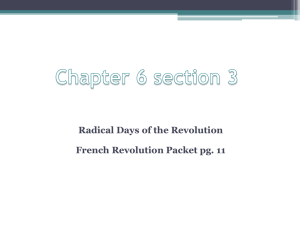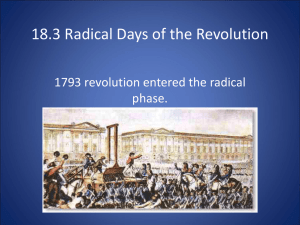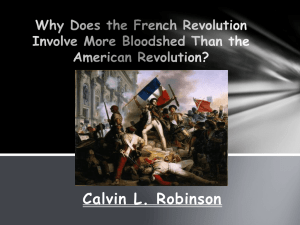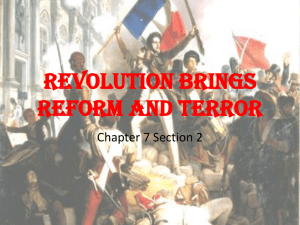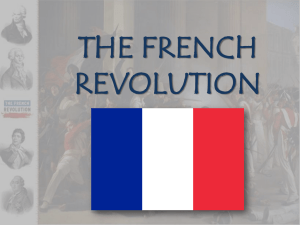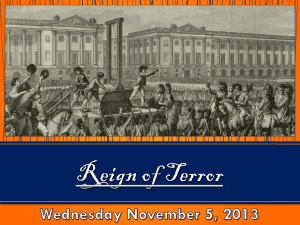Unit 5 FRQ French Rev Seminar
advertisement
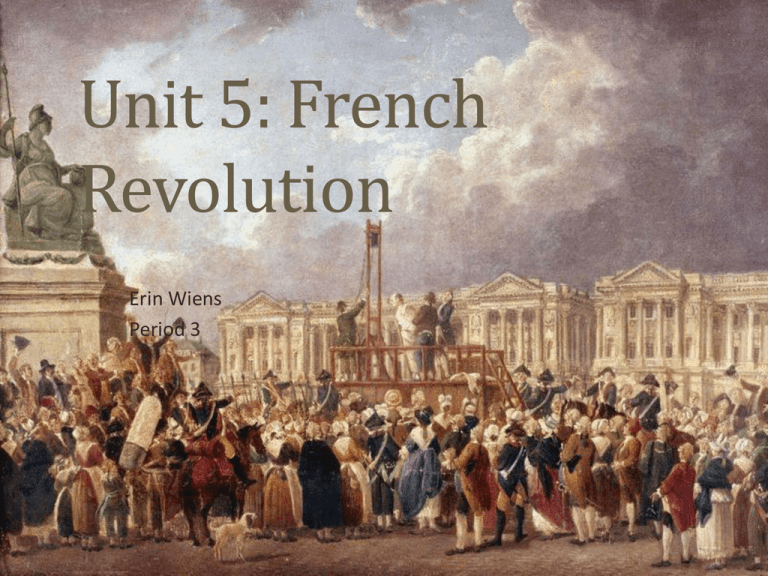
Unit 5: French Revolution Erin Wiens Period 3 Question To what extent and in what ways was the French Revolution during the period 1789 through the Reign of Terror (1794) an attempt to create a government based on Enlightened ideals? Thesis The French Revolution, from 1789 through the Reign of Terror in 1794, sought to radically transform France’s government based on Enlightened ideals. These transformations consisted of changes in individual rights, religion, and the political and economic systems. Groups of governmental power like the National Assembly, the Legislative Assembly, and the Committee of Public Safety all played their part in manufacturing these transformations. The National Assembly (1789-1791) • Issued the Declaration of the Rights of Man • Proclamations that Reflect Enlightment Ideals: • The people are source of political power • Men are born free and in equal rights • Purpose of government is to protect an individual’s natural rights The National Assembly’s constitutional monarchy • Reorganization of provinces: 83 districts • Uniform metric system • Abolished nobility as a legal order • Promoted the liberal concept of economic freedom • Prohibited monopolies and guilds • Barriers to trade within France were abolished • Reorganized France’s religious life • Nationalized the Catholic Church The Legislative Assembly (1791-1792) • Created after the disbandment of the National Assembly • New representative body of government • Jacobins • Committed to liberal revolution and distrusted the monarchy • April 1792: France declares war on Austria • Becomes War of First Coalition (Austria and Prussia) The Legislative Assembly Continued • Captured the king and his family when fleeing from the storming of the palace of Tuleries • Called for a new National Convention to be elected • National Convention (1792-1795) proclaimed France a republic • Abolished monarchy • New revolutionary calendar • Consisted of two groups: • Mountain: republicans • Girondins: moderate , rural populace Committee of Public Safety- 1793 • Formed by Maximilien Robespierre • An emergency committee given dictatorial powers by the Convention to deal with national emergency • Established planned economy: • Government set maximum prices and rationed food • Produced arms and munitions for the war • Developed socialist ideology Reign of Terror (1793-1794) • Used revolutionary terror to solidify home front • Tried rebels and “enemies of the state” for political crimes • More that 300,000 men and women were executed • Used as a weapon against anyone who opposed the new government Conclusion The period of the French Revolution from 1789 through the Reign of Terror in 1794 proved to be quite transforming to the government of France with the idea of Enlightment by its side. The National Assembly achieved a government based on enlightened ideals through their establishment of the Declaration of the Rights of Man, with its proclamations of men being born with equal rights with the government existing to protect those rights, and that the people being the source of political power. As for economics and politics, the Assembly managed to reorganize provinces, prohibit monopolies and guilds, eliminate trade barriers, and abolish nobility; therefore embracing more ideas of the Enlightment. Religious toleration was also an idea of the Enlightment that France embraced, but the nationalization of the Catholic Church turned things around. The time of the new Legislative Assembly consisted of completely abolishing the monarchy and creating a new republic France. The Committee of Public Safety then set up a planned economy and produced the Reign of Terror. So, overall, there were Enlightened ideals that were the base of the transformation of the government in France, but in the end it became twisted and lost with death and dictatorship.
